Teaching Reflection
- 格式:doc
- 大小:26.00 KB
- 文档页数:4
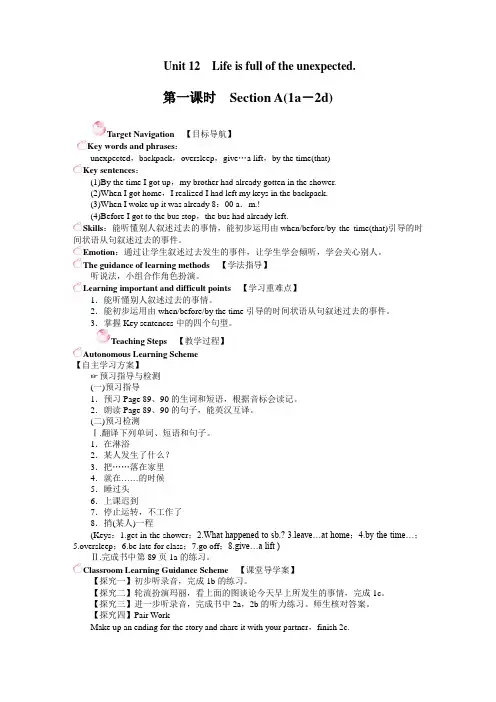
Unit 12Life is full of the unexpected.第一课时Section A(1a-2d)Target Navigation【目标导航】Key words and phrases:unexpected,backpack,oversleep,give…a lift,by the time(that)Key sentences:(1)By the time I got up,my brother had already gotten in the shower.(2)When I got home,I realized I had left my keys in the backpack.(3)When I woke up it was already 8:00 a.m.!(4)Before I got to the bus stop,the bus had already left.Skills:能听懂别人叙述过去的事情,能初步运用由when/before/by the time(that)引导的时间状语从句叙述过去的事件。
Emotion:通过让学生叙述过去发生的事件,让学生学会倾听,学会关心别人。
The guidance of learning methods【学法指导】听说法,小组合作角色扮演。
Learning important and difficult points【学习重难点】1.能听懂别人叙述过去的事情。
2.能初步运用由when/before/by the time引导的时间状语从句叙述过去的事件。
3.掌握Key sentences中的四个句型。
Teaching Steps【教学过程】Autonomous Learning Scheme【自主学习方案】☞预习指导与检测(一)预习指导1.预习Page 89、90的生词和短语,根据音标会读记。
2.朗读Page 89、90的句子,能英汉互译。
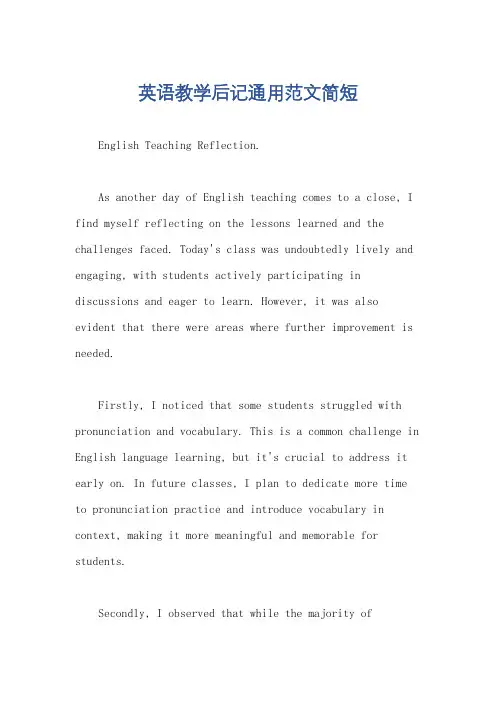
英语教学后记通用范文简短English Teaching Reflection.As another day of English teaching comes to a close, I find myself reflecting on the lessons learned and the challenges faced. Today's class was undoubtedly lively and engaging, with students actively participating in discussions and eager to learn. However, it was also evident that there were areas where further improvement is needed.Firstly, I noticed that some students struggled with pronunciation and vocabulary. This is a common challenge in English language learning, but it's crucial to address it early on. In future classes, I plan to dedicate more time to pronunciation practice and introduce vocabulary in context, making it more meaningful and memorable for students.Secondly, I observed that while the majority ofstudents were engaged in discussions, a few tended to zone out. This could be due to a lack of interest in the topic or a lack of understanding. To address this, I plan to introduce more real-world examples and applications of English language skills, making the subject more relevant and appealing to all students.Moreover, I recognized that the use of technology and multimedia could enhance the learning experience. In the future, I aim to integrate digital resources andinteractive tools into my lessons, creating a more dynamic and engaging learning environment.Additionally, I am aware that feedback from students is crucial for continuous improvement. I plan to conduct regular surveys and one-on-one discussions to gather their thoughts and suggestions on how to make the classes more effective and enjoyable.In conclusion, while today's class was a step in the right direction, there is still much to learn and improve upon. I am committed to providing my students with the bestpossible learning experience and am excited about the opportunities that lie ahead.The journey of teaching English is both rewarding and challenging, but I am confident that with dedication and continuous reflection, I can make a positive impact on my students' language skills and their overall development.。
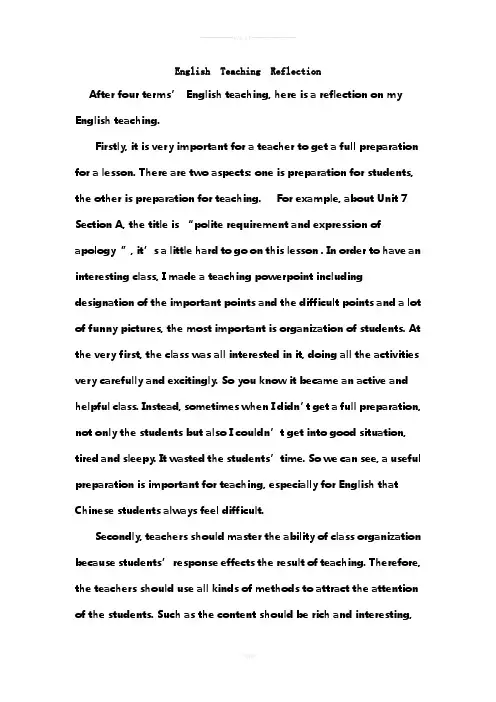
English Teaching ReflectionAfter four terms’English teaching, here is a reflection on my English teaching.Firstly, it is very important for a teacher to get a full preparation for a lesson. There are two aspects: one is preparation for students, the other is preparation for teaching. For example, about Unit 7 Section A, the title is “polite requirement and expression of apology ”, it’s a little hard to go on this lesson . In order to have an interesting class, I made a teaching powerpoint including designation of the important points and the difficult points and a lot of funny pictures, the most important is organization of students. At the very first, the class was all interested in it, doing all the activities very carefully and excitingly. So you know it became an active and helpful class. Instead, sometimes when I didn’t get a full preparation, not only the students but also I couldn’t get into good situation, tired and sleepy. It wasted the students’time. So we can see, a useful preparation is important for teaching, especially for English that Chinese students always feel difficult.Secondly, teachers should master the ability of class organization because students’response effects the result of teaching. Therefore, the teachers should use all kinds of methods to attract the attention of the students. Such as the content should be rich and interesting,but not too easy or not too difficult, and the procession should be natural. Thus the students can learn English at a very natural situation. For a teacher, he or she should be energetic every day. Coming back to my teaching, I feel a little upset for I can’t deal with my emotion better. When some students break the class rule, I suddently get so angry and the situation go on a long time that the lesson can’t be wonderful, or I should say it is pretty bad. From now on, getting over it becomes my emergency.Thirdly, students’interest should be aroused. About this point, one is helping students get an English name; one is talking about British and American culture and telling stories as much as possible; another is helping some students make penfriends with students in America. In these ways, students love English better, love learning English better, especially improve their English including writing ability.Fourthly, English is a kind of language. students need to reading more, speaking more, practice more except learning on class. The first: every morning----students’practice time, I go around the class, finding the students’problems, helping students find out the answer to the problem. The second: after class, I check every students’homework and help students find out the mistakes and correct them. The third, I also ask several students who are not veryinterested in English to recite the text to improve them.Fifthly, after the Mid-term exam and Final exam, i found two disadvantages: one is that there are many expecting-improving students, I plan to spend enough time in leading them to learn English, one is that the analysis ability of the students need to improve. In future, I must think over much more ways to do with the problem.The five points above are my teaching reflection. Now, I must improve myself, improve my students’English. Thanking for your guidance.10月14日reflection on the teachingI usually spend long time--- I should say----looking up in the dictionary and surfing on net for as much and complete information as I can, in order to enrich the class. But it appears that most of the time it is just for fun, and contributes little to the improvement, and even the motivation and enthusiasm, if there is any.However, I would be very nervous if I fail to make full preparation for the class, at least good enough in my view. And my textbook is underlined and marked here and there, which makes the other teacher who is in charge of the parellel class surprised. I knowalthough I can manage to give a three-hour class after a fashion, I would have a sense of guilty...Anyway, I have to learn to balance and budge the time, and grasp what is the most important!By the way, to communicate with others and sharing the experience is very important!。
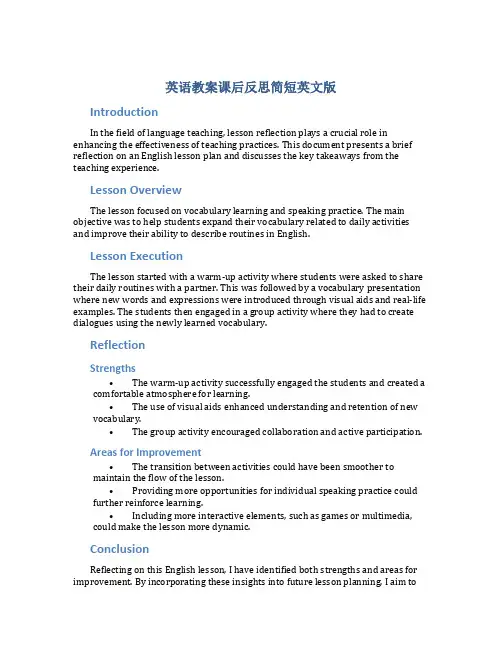
英语教案课后反思简短英文版IntroductionIn the field of language teaching, lesson reflection plays a crucial role in enhancing the effectiveness of teaching practices. This document presents a brief reflection on an English lesson plan and discusses the key takeaways from the teaching experience.Lesson OverviewThe lesson focused on vocabulary learning and speaking practice. The main objective was to help students expand their vocabulary related to daily activities and improve their ability to describe routines in English.Lesson ExecutionThe lesson started with a warm-up activity where students were asked to share their daily routines with a partner. This was followed by a vocabulary presentation where new words and expressions were introduced through visual aids and real-life examples. The students then engaged in a group activity where they had to create dialogues using the newly learned vocabulary.ReflectionStrengths•The warm-up activity successfully engaged the students and created a comfortable atmosphere for learning.•The use of visual aids enhanced understanding and retention of new vocabulary.•The group activity encouraged collaboration and active participation.Areas for Improvement•The transition between activities could have been smoother to maintain the flow of the lesson.•Providing more opportunities for individual speaking practice could further reinforce learning.•Including more interactive elements, such as games or multimedia, could make the lesson more dynamic.ConclusionReflecting on this English lesson, I have identified both strengths and areas for improvement. By incorporating these insights into future lesson planning, I aim tocreate more engaging and effective learning experiences for my students. Through continuous reflection and refinement, I strive to become a better language instructor.This document serves as a concise reflection on an English lesson plan, highlighting both successful aspects and areas for development. By analyzing the teaching experience, educators can enhance their teaching practices and create more impactful learning environments for students.。
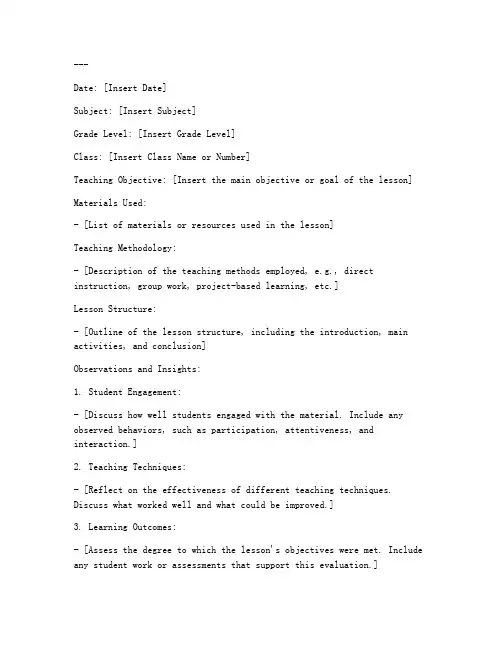
---Date: [Insert Date]Subject: [Insert Subject]Grade Level: [Insert Grade Level]Class: [Insert Class Name or Number]Teaching Objective: [Insert the main objective or goal of the lesson]Materials Used:- [List of materials or resources used in the lesson]Teaching Methodology:- [Description of the teaching methods employed, e.g., direct instruction, group work, project-based learning, etc.]Lesson Structure:- [Outline of the lesson structure, including the introduction, main activities, and conclusion]Observations and Insights:1. Student Engagement:- [Discuss how well students engaged with the material. Include any observed behaviors, such as participation, attentiveness, and interaction.]2. Teaching Techniques:- [Reflect on the effectiveness of different teaching techniques. Discuss what worked well and what could be improved.]3. Learning Outcomes:- [Assess the degree to which the lesson's objectives were met. Include any student work or assessments that support this evaluation.]4. Classroom Management:- [Analyze how well the classroom was managed. Consider aspects such as discipline, pacing, and the ability to maintain a positive learning environment.]5. Time Management:- [Evaluate the efficiency of time management during the lesson. Discuss any delays or areas where the lesson could have been more concise.]Challenges and Solutions:1. Identified Challenges:- [List any challenges encountered during the lesson, such as student misunderstanding, technical difficulties, or unexpected issues.]2. Proposed Solutions:- [Offer potential solutions or adjustments that could be made to address these challenges more effectively in the future.]Reflection on Personal Practice:1. Areas of Strength:- [Identify areas where the teaching practice was particularlysuccessful and consider why these strategies worked well.]2. Areas for Improvement:- [Identify specific areas where there is room for growth or improvement. Discuss what steps can be taken to develop these skills or competencies.]Action Plan for Future Lessons:1. Adjustments to Teaching Methods:- [Outline any changes to the teaching methods that will be implemented in future lessons based on this reflection.]2. Student Learning Support:- [Describe any additional support or resources that will be provided to students to enhance their learning and understanding.]Conclusion:- [Summarize the key takeaways from the reflection and express any personal feelings or thoughts about the teaching experience.]---Note: This template can be adapted to fit various teaching contexts and subjects. It provides a structured format for teachers to reflect on their practice and plan for continuous improvement.。
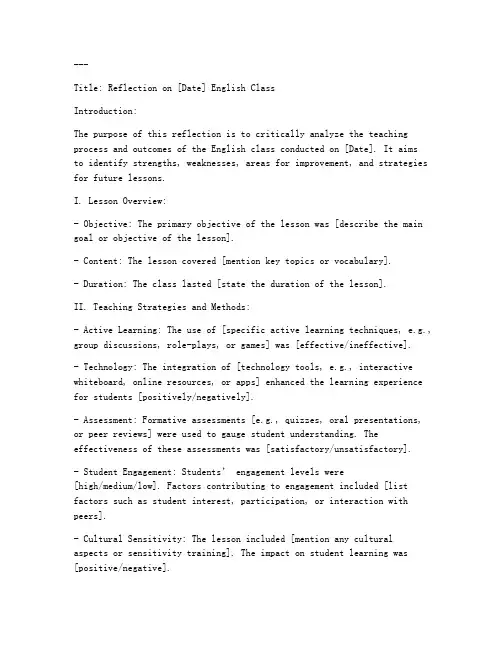
---Title: Reflection on [Date] English ClassIntroduction:The purpose of this reflection is to critically analyze the teaching process and outcomes of the English class conducted on [Date]. It aimsto identify strengths, weaknesses, areas for improvement, and strategies for future lessons.I. Lesson Overview:- Objective: The primary objective of the lesson was [describe the main goal or objective of the lesson].- Content: The lesson covered [mention key topics or vocabulary].- Duration: The class lasted [state the duration of the lesson].II. Teaching Strategies and Methods:- Active Learning: The use of [specific active learning techniques, e.g., group discussions, role-plays, or games] was [effective/ineffective].- Technology: The integration of [technology tools, e.g., interactive whiteboard, online resources, or apps] enhanced the learning experience for students [positively/negatively].- Assessment: Formative assessments [e.g., quizzes, oral presentations, or peer reviews] were used to gauge student understanding. The effectiveness of these assessments was [satisfactory/unsatisfactory].- Student Engagement: Students’ engagement levels were[high/medium/low]. Factors contributing to engagement included [list factors such as student interest, participation, or interaction with peers].- Cultural Sensitivity: The lesson included [mention any culturalaspects or sensitivity training]. The impact on student learning was [positive/negative].III. Student Performance:- Overall Understanding: The majority of students demonstrated [mention level of understanding, e.g., good, moderate, or poor] of the lesson’s content.- Individual Variability: There was a range of understanding among students, with [mention specific examples, e.g., students struggling with grammar or those excelling in vocabulary].- Homework Completion: The submission rate for homework was [mention the rate, e.g., 90%]. Reasons for non-completion included [list reasons,e.g., lack of time, technical difficulties, or personal issues].IV. Challenges and Solutions:- Challenges: The main challenges encountered during the lesson were [mention challenges, e.g., language barriers, lack of student participation, or technical issues].- Solutions: To address these challenges, I implemented [mention solutions, e.g., providing additional support, encouraging student participation, or seeking technical assistance].V. Areas for Improvement:- Content Delivery: I plan to [mention specific improvements, e.g., clarify complex concepts, provide more examples, or adjust the pacing of the lesson].- Assessment: To improve formative assessments, I will [mention improvements, e.g., incorporate more varied types of assessments, provide immediate feedback, or offer revision opportunities].- Student Engagement: Enhancing student engagement could be achieved by [mention strategies, e.g., incorporating more interactive activities, creating a more inclusive classroom environment, or using student feedback to tailor lessons].- Cultural Considerations: To better cater to diverse cultural backgrounds, I will [mention actions, e.g., include more culturallyrelevant materials, encourage students to share their experiences, or provide cultural sensitivity training].VI. Conclusion:In conclusion, the English class on [Date] provided valuable insights into both the successes and challenges of teaching. While the students demonstrated a good understanding of the lesson’s content, there is room for improvement in certain areas. By reflecting on this experience and implementing the suggested strategies, I am confident that future lessons will be more effective and engaging for all students.---This template can be adapted to fit the specific context and requirements of any English teaching reflection.。
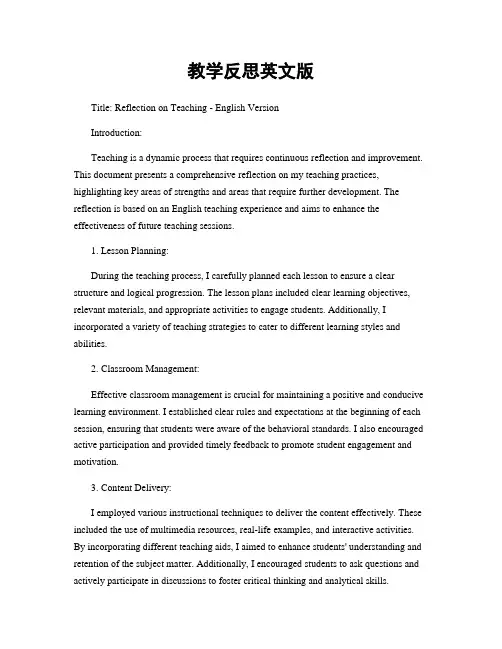
教学反思英文版Title: Reflection on Teaching - English VersionIntroduction:Teaching is a dynamic process that requires continuous reflection and improvement. This document presents a comprehensive reflection on my teaching practices, highlighting key areas of strengths and areas that require further development. The reflection is based on an English teaching experience and aims to enhance the effectiveness of future teaching sessions.1. Lesson Planning:During the teaching process, I carefully planned each lesson to ensure a clear structure and logical progression. The lesson plans included clear learning objectives, relevant materials, and appropriate activities to engage students. Additionally, I incorporated a variety of teaching strategies to cater to different learning styles and abilities.2. Classroom Management:Effective classroom management is crucial for maintaining a positive and conducive learning environment. I established clear rules and expectations at the beginning of each session, ensuring that students were aware of the behavioral standards. I also encouraged active participation and provided timely feedback to promote student engagement and motivation.3. Content Delivery:I employed various instructional techniques to deliver the content effectively. These included the use of multimedia resources, real-life examples, and interactive activities. By incorporating different teaching aids, I aimed to enhance students' understanding and retention of the subject matter. Additionally, I encouraged students to ask questions and actively participate in discussions to foster critical thinking and analytical skills.4. Differentiation and Individualized Support:Recognizing the diverse needs and abilities of students, I implemented strategies to differentiate instruction and provide individualized support. This included modifying tasks and materials to accommodate different learning styles, providing additional resources for struggling students, and challenging advanced learners with extension activities. Regular assessments were conducted to monitor student progress and identify areas requiring additional support.5. Assessment and Feedback:To ensure accurate assessment and promote student growth, I employed a variety of assessment methods, including formative and summative assessments. These assessments were aligned with the learning objectives and provided opportunities for students to demonstrate their understanding. Additionally, I provided timely and constructive feedback to students, highlighting their strengths and areas for improvement. This feedback aimed to enhance learning and motivate students to strive for excellence.6. Integration of Technology:Recognizing the importance of technology in modern education, I integrated various technological tools and resources into my teaching. This included the use of interactive whiteboards, educational software, online platforms, and multimedia presentations. By incorporating technology, I aimed to enhance student engagement, facilitate collaborative learning, and promote digital literacy skills.7. Continuous Professional Development:As an educator, I understand the significance of continuous professional development. I actively engage in workshops, conferences, and online courses to stay updated with the latest teaching methodologies and research. This allows me to incorporate innovative approaches into my teaching practice and provide the best possible learning experiences for my students.Conclusion:This reflection on my English teaching experience highlights the various aspects of effective teaching, including lesson planning, classroom management, content delivery, differentiation, assessment, integration of technology, and continuous professional development. By critically analyzing my teaching practices, I can identify areas of strength and areas that require improvement. This reflection serves as a valuable tool for enhancing my teaching skills and ensuring a positive and impactful learning experience for my students.。
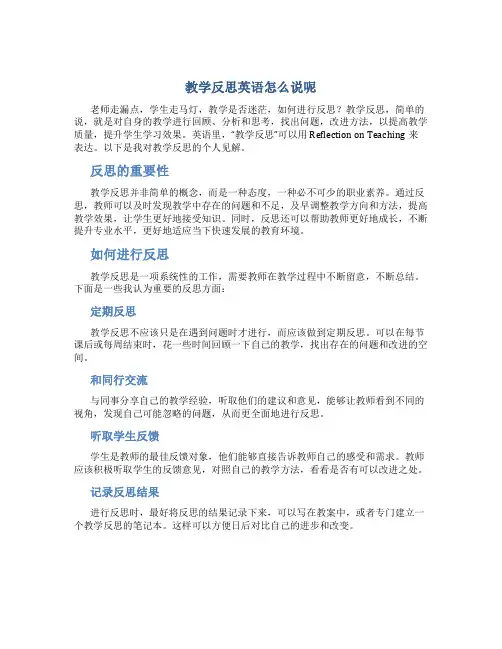
教学反思英语怎么说呢老师走漏点,学生走马灯,教学是否迷茫,如何进行反思?教学反思,简单的说,就是对自身的教学进行回顾、分析和思考,找出问题,改进方法,以提高教学质量,提升学生学习效果。
英语里,“教学反思”可以用Reflection on Teaching来表达。
以下是我对教学反思的个人见解。
反思的重要性教学反思并非简单的概念,而是一种态度,一种必不可少的职业素养。
通过反思,教师可以及时发现教学中存在的问题和不足,及早调整教学方向和方法,提高教学效果,让学生更好地接受知识。
同时,反思还可以帮助教师更好地成长,不断提升专业水平,更好地适应当下快速发展的教育环境。
如何进行反思教学反思是一项系统性的工作,需要教师在教学过程中不断留意,不断总结。
下面是一些我认为重要的反思方面:定期反思教学反思不应该只是在遇到问题时才进行,而应该做到定期反思。
可以在每节课后或每周结束时,花一些时间回顾一下自己的教学,找出存在的问题和改进的空间。
和同行交流与同事分享自己的教学经验,听取他们的建议和意见,能够让教师看到不同的视角,发现自己可能忽略的问题,从而更全面地进行反思。
听取学生反馈学生是教师的最佳反馈对象,他们能够直接告诉教师自己的感受和需求。
教师应该积极听取学生的反馈意见,对照自己的教学方法,看看是否有可以改进之处。
记录反思结果进行反思时,最好将反思的结果记录下来,可以写在教案中,或者专门建立一个教学反思的笔记本。
这样可以方便日后对比自己的进步和改变。
结语教学反思是每位教师应该具备的素质,只有不断地反思自己的教学才能进步、优化教学,为学生提供更好的教育服务。
希望每位教师都能重视教学反思,让自己的教学更上一层楼。
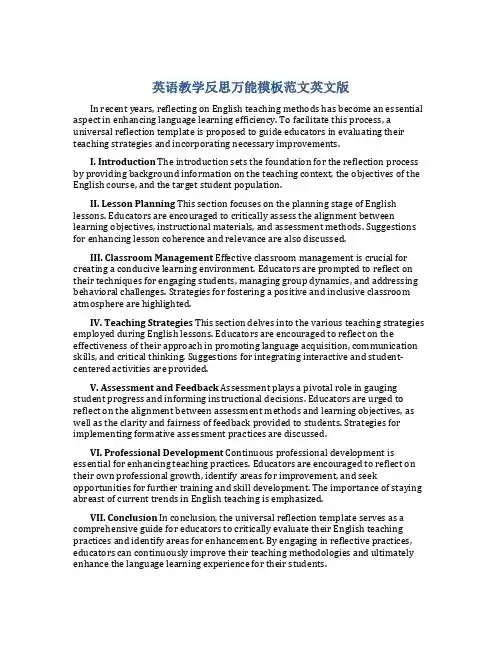
英语教学反思万能模板范文英文版In recent years, reflecting on English teaching methods has become an essential aspect in enhancing language learning efficiency. To facilitate this process, a universal reflection template is proposed to guide educators in evaluating their teaching strategies and incorporating necessary improvements.I. Introduction The introduction sets the foundation for the reflection process by providing background information on the teaching context, the objectives of the English course, and the target student population.II. Lesson Planning This section focuses on the planning stage of English lessons. Educators are encouraged to critically assess the alignment between learning objectives, instructional materials, and assessment methods. Suggestions for enhancing lesson coherence and relevance are also discussed.III. Classroom Management Effective classroom management is crucial for creating a conducive learning environment. Educators are prompted to reflect on their techniques for engaging students, managing group dynamics, and addressing behavioral challenges. Strategies for fostering a positive and inclusive classroom atmosphere are highlighted.IV. Teaching Strategies This section delves into the various teaching strategies employed during English lessons. Educators are encouraged to reflect on the effectiveness of their approach in promoting language acquisition, communication skills, and critical thinking. Suggestions for integrating interactive and student-centered activities are provided.V. Assessment and Feedback Assessment plays a pivotal role in gauging student progress and informing instructional decisions. Educators are urged to reflect on the alignment between assessment methods and learning objectives, as well as the clarity and fairness of feedback provided to students. Strategies for implementing formative assessment practices are discussed.VI. Professional Development Continuous professional development is essential for enhancing teaching practices. Educators are encouraged to reflect on their own professional growth, identify areas for improvement, and seek opportunities for further training and skill development. The importance of staying abreast of current trends in English teaching is emphasized.VII. Conclusion In conclusion, the universal reflection template serves as a comprehensive guide for educators to critically evaluate their English teaching practices and identify areas for enhancement. By engaging in reflective practices, educators can continuously improve their teaching methodologies and ultimately enhance the language learning experience for their students.Through the utilization of the English teaching reflection template, educators can effectively assess their teaching practices, pinpoint areas for improvement, and make informed decisions to enhance the overall learning experience for students. By adopting a reflective approach to English teaching, educators can continuously refine their strategies, adapt to the evolving needs of their students, and cultivate a dynamic and engaging classroom environment.。
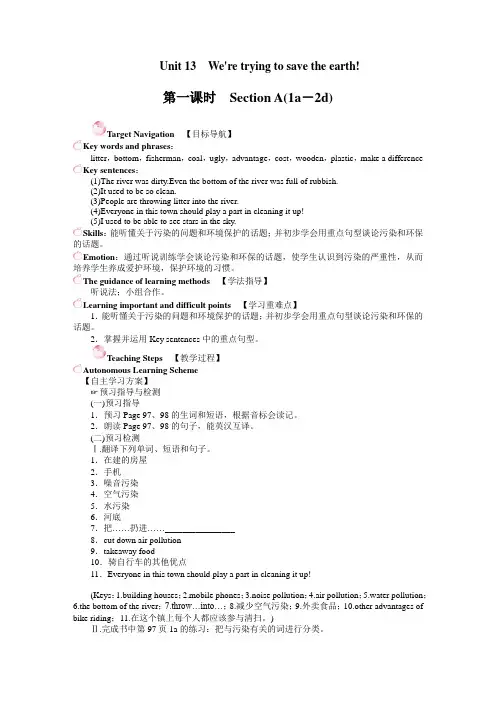
Unit 13We're trying to save the earth!第一课时Section A(1a-2d)Target Navigation【目标导航】Key words and phrases:litter,bottom,fisherman,coal,ugly,advantage,cost,wooden,plastic,make a difference Key sentences:(1)The river was dirty.Even the bottom of the river was full of rubbish.(2)It used to be so clean.(3)People are throwing litter into the river.(4)Everyone in this town should play a part in cleaning it up!(5)I used to be able to see stars in the sky.Skills:能听懂关于污染的问题和环境保护的话题;并初步学会用重点句型谈论污染和环保的话题。
Emotion:通过听说训练学会谈论污染和环保的话题,使学生认识到污染的严重性,从而培养学生养成爱护环境,保护环境的习惯。
The guidance of learning methods【学法指导】听说法;小组合作。
Learning important and difficult points【学习重难点】1.能听懂关于污染的问题和环境保护的话题;并初步学会用重点句型谈论污染和环保的话题。
2.掌握并运用Key sentences中的重点句型。
Teaching Steps【教学过程】Autonomous Learning Scheme【自主学习方案】☞预习指导与检测(一)预习指导1.预习Page 97、98的生词和短语,根据音标会读记。
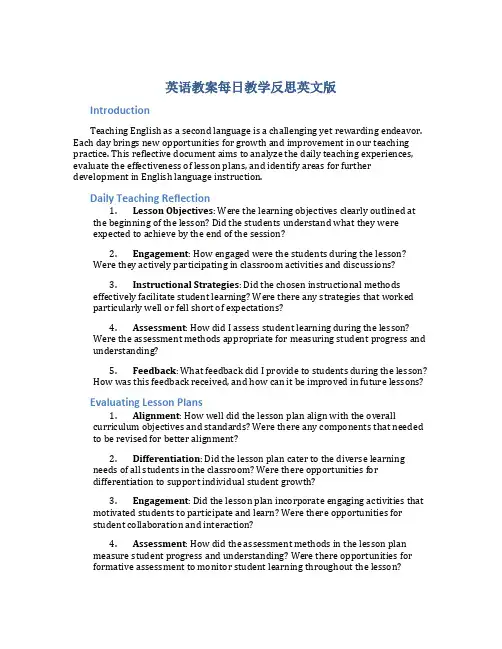
英语教案每日教学反思英文版IntroductionTeaching English as a second language is a challenging yet rewarding endeavor. Each day brings new opportunities for growth and improvement in our teaching practice. This reflective document aims to analyze the daily teaching experiences, evaluate the effectiveness of lesson plans, and identify areas for further development in English language instruction.Daily Teaching Reflection1.Lesson Objectives: Were the learning objectives clearly outlined atthe beginning of the lesson? Did the students understand what they wereexpected to achieve by the end of the session?2.Engagement: How engaged were the students during the lesson?Were they actively participating in classroom activities and discussions?3.Instructional Strategies: Did the chosen instructional methodseffectively facilitate student learning? Were there any strategies that worked particularly well or fell short of expectations?4.Assessment: How did I assess student learning during the lesson?Were the assessment methods appropriate for measuring student progress and understanding?5.Feedback: What feedback did I provide to students during the lesson?How was this feedback received, and how can it be improved in future lessons?Evaluating Lesson Plans1.Alignment: How well did the lesson plan align with the overallcurriculum objectives and standards? Were there any components that needed to be revised for better alignment?2.Differentiation: Did the lesson plan cater to the diverse learningneeds of all students in the classroom? Were there opportunities fordifferentiation to support individual student growth?3.Engagement: Did the lesson plan incorporate engaging activities thatmotivated students to participate and learn? Were there opportunities forstudent collaboration and interaction?4.Assessment: How did the assessment methods in the lesson planmeasure student progress and understanding? Were there opportunities for formative assessment to monitor student learning throughout the lesson?5.Reflection: After teaching the lesson, what modifications would Imake to the lesson plan for future implementation? How can the lesson plan be improved to enhance student learning outcomes?Areas for Development1.Student Engagement: How can I further enhance studentengagement in the classroom to promote active learning and participation?2.Differentiation: What strategies can be implemented to betterdifferentiate instruction and support the diverse learning needs of students?3.Feedback: How can I improve the feedback provided to students topromote a growth mindset and continuous improvement in their Englishlanguage skills?4.Professional Development: What professional developmentopportunities can I pursue to enhance my English language teaching skills and knowledge?5.Collaboration: How can I collaborate with colleagues to share bestpractices, resources, and strategies for effective English language instruction?ConclusionReflecting on daily teaching experiences and evaluating lesson plans are essential components of professional growth and development as an English language instructor. By continuously assessing our teaching practice and seeking opportunities for improvement, we can create a more engaging and effective learning environment for our students. Through ongoing reflection and self-assessment, we can strive to be lifelong learners and dedicated educators in the field of English language instruction.This document serves as a reflection on daily English language teaching practices and aims to enhance teaching effectiveness through self-assessment and continuous improvement.。
Title: Reflection on Teaching English---Introduction:The purpose of this reflection is to critically analyze and evaluate the effectiveness of my teaching methods in an English language classroom. It aims to identify strengths, weaknesses, and areas for improvement, ultimately contributing to the enhancement of my teaching skills and the learning experience of my students.---I. Teaching Context:- Class Details: Briefly describe the class composition, including the number of students, their age range, proficiency levels, and anyspecific learning needs or challenges.- Curriculum Overview: Outline the main topics covered in the lesson, the objectives set, and the learning outcomes expected.---II. Teaching Strategies and Methods:- Interactive Activities: Discuss the use of interactive activities, such as group work, role-plays, and discussions, and reflect on their impact on student engagement and participation.- Technology Integration: Evaluate the effectiveness of integrating technology tools (e.g., interactive whiteboards, online resources) in enhancing the learning experience.- Assessment Techniques: Analyze the assessment methods used (e.g., quizzes, presentations, portfolios) and reflect on their reliability and contribution to student learning.---III. Student Engagement and Participation:- Observations: Describe the level of student engagement andparticipation observed during the lesson. Were students actively involved, or were there signs of disinterest or confusion?- Feedback: Share any feedback received from students or colleagues regarding the lesson's effectiveness.- Adaptations: Reflect on any adaptations made during the lesson tocater to different learning styles or needs.---IV. Learning Outcomes:- Achievement: Assess the extent to which the learning outcomes were met. Were the students able to demonstrate the knowledge and skills taught?- Challenges: Identify any challenges faced by students in achieving the learning outcomes and consider possible reasons.- Success Stories: Share examples of successful student learning and achievements.---V. Self-Assessment:- Strengths: Acknowledge the aspects of your teaching that were successful. What made these strategies effective?- Weaknesses: Critically evaluate areas where the lesson fell short. What aspects did not work as well as anticipated?- Professional Development: Reflect on how you can improve your teaching practice. What professional development opportunities or resources would be beneficial?---VI. Conclusion and Action Plan:- Summary: Summarize the key points of your reflection, highlighting the strengths and weaknesses identified.- Action Plan: Outline a specific action plan for addressing the weaknesses and enhancing your teaching practice. This may include additional resources, changes in teaching strategies, or further professional development.---Conclusion:This reflection has provided valuable insights into my teaching practice. By acknowledging both my strengths and weaknesses, I am better equipped to tailor my teaching methods to the needs of my students and continuously improve their learning experience. Through ongoing self-assessment and professional development, I am committed to enhancing my teaching skills and fostering an engaging and effective English language learning environment.。
什么是反思性教学What is the reflective teaching反思性教学是指教师在一般的教育教学规律或者教育理论的指导下,对教学经验进行回顾、审视与重新认识,从而产生新的更趋合理的教学方案与教学行为的过程。
也就是说,反思性教学既有“教学的反思”,也有“反思的教学”,是二者的有机统一。
熊川武提出了反思性教学的三点内涵:反思性教学以探究和解决教学问题为基本点;反思性教学以追求教学实践合理性为动力;反思性教学是帮助教师全面发展的过程。
Reflective teaching refers to teachers in ordinary education teaching rule or under the guidance of education theory, the experience in teaching, review, review, and the resulting new more hasten is reasonable teaching plan and teaching behavior process. That is to say, reflective teaching has both the "teaching reflection" and "reflective teaching", is the organic unity of both. Xiong Chuanwu three connotation of reflective teaching is put forward: to explore and solve teaching problems in reflective teaching; Reflective teaching driven by the pursuit of teaching practice rationality; Reflective teaching is to help the teachers' overall development process.因此,反思性教学要追求教学目标、教学手段、教学实践的合理性和有效性,通过审视、探讨、研究教学实践中的实际问题,来实现教学改善和教师的专业发展。
Reflection on Teaching EnglishTeaching English is a dynamic and multifaceted process that requires constant reflection and evaluation of one’s teaching methods and strategies. This reflective practice is essential for educators to continuously improve and enhance their teaching effectiveness.As an English teacher, I believe that reflection plays a crucial role in my professional growth and development. It allows me to critically examine my teaching practices, identify areas for improvement, and make necessary adjustments to better meet the needs of my students.One aspect of teaching English that I often reflect upon is the effectiveness of my lesson planning. I ask myself questions such as: Are my learning objectives clear and achievable? Do my instructional materials cater to different learning styles and preferences? Am I providing enough opportunities for student engagement and participation? By reflecting on these questions, I am able to fine-tune my lesson plans and make them more engaging and effective for my students.Another important aspect of teaching that I reflect upon is my classroom management strategies. I ask myself: Am I creating a positive and inclusive learning environment for all students? Am I effectively managing student behavior and maintaining a productive learning atmosphere? Through reflection, I am able to identify areas where I can improve my classroom management skills and create a more conducive learning environment for my students.In addition to lesson planning and classroom management, I also reflect upon my assessment and feedback practices. I ask myself: Am I providing timely and constructive feedback to my students? Are my assessments aligned with the learning objectives and reflective of student understanding? By reflecting on these questions, I am able to improve my assessment and feedback practices to better support student learning and growth.Overall, reflection is an integral part of my teaching practice. It allows me to continuously evaluate and refine my teaching methods and strategies to ensure that I am providing the best possible learning experience for my students. By engaging in reflective practice, I am able to grow as an educator and make a positive impact on the learning outcomes of my students.。
人教版八年级下册英语教学设计含教学反思Teaching Plan for People's Education Press 8th Grade English Curriculum with Teaching ReflectionTeaching Objectives:1. To help students improve their listening, speaking, reading, and writing skills in English.2. To expand students' vocabulary and grammar knowledge.3. To enhance students' understanding of English culture and communication skills.4. To develop students' critical thinking and problem-solving abilities.Teaching Content:Unit 1: School Life - Talking about different subjects and activities at school.Unit 2: Travel - Discussing different modes of transportation and travel destinations.Unit 3: My Future - Describing future plans and goals.Unit 4: Stories - Reading and analyzing short stories.Unit 5: Communication - Practicing effective communication skills in English.Teaching Methods:1. Communicative Approach: Encouraging students to actively participate in class discussions and group activities.2. Task-based Learning: Assigning tasks and projects that require students to apply what they have learned in real-life situations.3. Multimedia Resources: Using videos, songs, and online resources to make learning more engaging and interactive.4. Pair and Group Work: Promoting cooperation and teamwork among students in various language activities.Teaching Activities:1. Role-plays: Having students act out scenarios related to the unit themes.2. Vocabulary Games: Playing word games to reinforce new vocabulary.3. Reading Comprehension Exercises: Analyzing and discussing reading passages.4. Writing Assignments: Asking students to write essays, letters, and stories based on the unit topics.5. Listening Tasks: Listening to audio clips and answering questions to improve listening skills.Teaching Reflection:Overall, the teaching plan for the People's Education Press 8th Grade English Curriculum was successful in achieving its objectives. Students showed improvement in their language skills and were able to use English in real-life situations. The communicative approach and task-based learning activities were effective in engaging students and making learning more interactive. However, there are areas for improvement, such as providing more opportunities for student-led discussions and incorporating more multimedia resources into lessons. Overall, the teaching plan was effective in helping students achieve their learning goals and fostering a positive learning environment.。
Teaching ReflectionUnit5 topic1SectionAIt’s easy for the students to understand the structure of “linking verb + adjective”. But it’s a little hard for the students to use the correct form ofthe linking verbs in their own conversations. Teacher should design more oral practice for the students.SectionBStudents understand the structure of “linking verb + adjective” well and they can make up right sentences with it. But they need more exercises about the usages of adjectives ended with –ed and –ing. They are very interested in the movie The Sound of Music after learning Section A and B.It’s helpful for them to learn Section C.SectionCThe students like the two beautiful songs from The Sound of Music very much. The whole atmosphere of this lesson is active. It’s helpful to English teaching and learning. We should show more information that the students are interested in when we have the English class.SectionDStudents are weak in writing practice. The teacher should pay more attention to the writing teaching. Design the writing steps carefully. The teacher may let students enjoy a real Beijing Opera after class.Unit5 topic2SectionAThe students can grasp the adverbial clauses well after the learning of Sections A and B. And they can offer the right suggestions to others when others are in a bad mood.SectionBIn today’s lesson, the teacher should let the students know that everyone needs help when he is in a bad mood, so we should give others a hand when they feel upset. At the same time the teacher should design more exercises about the phrasesmentioned in Section A.SectionCMost of the students can grasp the equal comparison structure, and the teacher should design more exercises as their homework.SectionDStudents are weak in giving advice to people in bad moods. The teacher should design more exercises about adjectives to describe feelings and emotions and verbs to give advice. The teacher should pay more attention to the writing teaching. Design the writing steps carefully.Unit5 topic3SectionAI t’s a little hard for the students to understand the sentence structures well. It’s necessary for the teacher to design more exercises for consolidation. And the teacher should let the students know that everyone needs help when he is in a bad mood, so we should give others a hand when they feels unhappy.SectionBAfter finishing the exercises of 2, the students could understand the sentence structures well. They could also grasp the pronunciation of 3a. At the same time, they did well in the reading of 3b. After class, the teacher should design some exercises to consolidate the usage of the phrases of 1b.SectionCThe students know many things that can affect the feelings, and they are very interested in them. And there are many things that can help them keep away from the bad moods and keep their mentality healthy.SectionDIt’s very important to teach the students how to take good care of themselves. The teacher should pay more attention to the writing guide. Design the writing steps carefully.Unit6 topic1SectionAThe students are interested in traveling, and they can take an active part in all the activities. They finished the recommendation task well. But they can’t understand the usage of infinitives, so the teacher should design more learning activities for the students to grasp the structure.SectionBThe students have grasped how to book tickets and hotels well in English, and they can understand a little about the usages of infinitives. The teacher should design more learning activities for the students to grasp the structure.SectionCThe students are very interested in the way of raising money. They grasp the usage of infinitives well by doing the exercises of 2.SectionDThe students can talk about traveling fluently after the learning of this topic. They can grasp the usage of infinitives better now. The teacher should design more exercises for them for consolidation.Unit6 topic2SectionAThe students like Beijing very much. They are interested in exploring Beijing. They can grasp the sentences about invitation, suggestion, agreement and request well. And they understand the usage of adverbial clause of time easily.SectionBThe students all like the great buildings of Tian’anmen Square. They express their love to Beijing and our gre at country. It’s more important than the language knowledge. They can grasp the nouns of direction and prepositions of position better, but it’s still necessary to offer more exercises to them.SectionCThe students are very interested in the three boys’ t raveling experience. They can take an active part in all the activities. They also like the beautiful scenes of Jiuzhaigou. The teacher may offer more places of interest to them to widen their horizon.SectionDThe students can write their traveling diaries well with the useful expressions. They can also grasp adverbial clauses of time better now. The teacher should design more exercises for them for consolidation.Unit6 topic3SectionAThe students realize the terrible results of the traffic accidents. Now they know that it’s very important to follow the traffic rules. And they know about the advantages of cycling. They can understand the usage of adverbial clauses of condition briefly.SectionBThe students are amazed at the number of the people who died from the traffic accidents every year. They realize that it’s very important to follow the traffic rules. And they do very well in making traffic rules. They can understand the usage of adverbial clauses of condition well.SectionCThe students know about that bicycle riding is good exercise, but it’s also very dangerous if we don’t follow the traffic rules, so we must be careful when riding.SectionDThe students grasp the knowledge of this topic well after the review of this section. Boys are very interes ted in the bicycle race. And they can evaluate others’ productions better and learn something useful from them.。